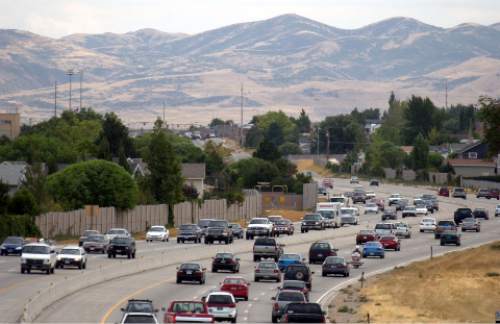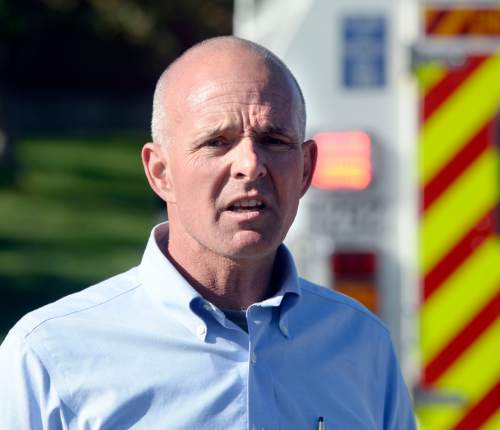This is an archived article that was published on sltrib.com in 2016, and information in the article may be outdated. It is provided only for personal research purposes and may not be reprinted.
Oregon volunteers are testing a plan to replace its 31.1 cents per gallon state gasoline tax with a new system charging 1.5 cents for every mile residents drive (based on odometer readings). California is about to launch a similar pilot program.
Those states say that taxing gas by the gallon no longer covers highway costs. That's because drivers are buying less fuel because cars have increasingly better mileage, and because more motorists are switching to electric, hybrid or natural-gas vehicles. More people also ride transit or bikes. And a by-the-gallon tax doesn't keep up with inflation.
But Utah officials say such funding difficulties are a relatively distant problem here — and they expect no move to a "vehicle miles traveled" (VMT) tax any time soon, although they say it could be possible in future decades.
Why? Lawmakers adequately covered Utah's highway maintenance needs last year for the foreseeable future when it approved not only a 4.9 cent gas tax that took effect Jan. 1, but changed laws so that it will automatically rise with inflation, highway officials say. That will happen until the current 29.4 cent tax reaches 40 cents a gallon.
"I believe we have sustainable funding here — not just in the near future, but for 20 to 30 years," says Carlos Braceras, executive director of the Utah Department of Transportation.
The automatically adjusting gas tax — plus state use of additional sales taxes for transportation, even though they were trimmed this year — "puts us in a unique position in Utah," which Braceras says other states envy.
He said it allows the state to handle road repairs when they are small and cheap, before they grow into expensive rebuilding projects.
"It will result in a lower cost of ownership for the state, because good roads cost less," he said. "We are going to be able to maintain our infrastructure in a condition that's ultimately going to cost the taxpayers less money."
Just before the Legislature last year passed HB362 to raise the gas tax for the first time in 17 years, UDOT finished a study about how much buying power the gas tax would likely lose over time to inflation and changing driving habits.
"By the year 2040, it found that could result in a 30 percent decline in the purchasing power of the fuel tax," said Linda Hull, UDOT director of policy and legislative services.
Even though that is big, "It wasn't as bad as I thought it would be," Hull said. "I thought, 'Oh, we've got time'" to figure out how to replace the lost buying power of the gas tax — especially as the Legislature changed the gas tax to rise with inflation.
Braceras says he figures it bought 20 or 30 years, and credits what he says is some political bravery by legislators to raise the tax.
"They saw the need. They saw the benefits, and they did the right thing" by raising the tax, and allowing it to rise automatically, he said.
Braceras adds that Congress is looking at the alternate VMT tax "because they don't seem to have the will to do the right thing," or raise federal gasoline taxes. Congress recently authorized $90 million in grants to states willing to experiment with that new VMT system, as Oregon and California are.
Hull said that as part of HB362, legislators also allowed UDOT to continue in a consortium of Western states looking at future alternatives to the gasoline tax — including a VMT tax.
But Braceras says the world of transportation is changing so fast that the likely solution to future funding for it has not yet been discovered.
He said more people are taking transit or biking. Advanced safety systems are allowing lighter vehicles, which get better mileage. And self-driving vehicles are appearing. Figuring out how to tax that to provide highways could be a challenge.
"It's probably something we haven't figured out yet," Braceras said about the future solution. "I think it might be something much different."
Of note, Utah's current state gas tax of 24.9 cents a gallon is 24th highest among the 50 states, according to the Tax Foundation. The most expensive state tax is in Pennsylvania, at 50.4 cents a gallon. The cheapest is in Alaska at 12.25 cents. That does not include the 18.4 cents per gallon federal gasoline tax.
Because of inflation, the Utah Transportation Coalition — formed by the Salt Lake Chamber, cities and counties — figured that Utah's previous gasoline tax of 24.5 cents a gallon had lost 40 percent of buying power since it was last increased in 1997, essentially being only worth 14.7 cents.
The Legislature did cut back some sales taxes this year that previously had been earmarked for transportation. Over seven years, the plan would transfer $172.2 million to the general fund where it would likely be spent on education, and another $165.5 million into a special fund for water development.
Braceras has said the transfer will not delay any currently approved and scheduled projects, but may slow the pace of other future projects.





